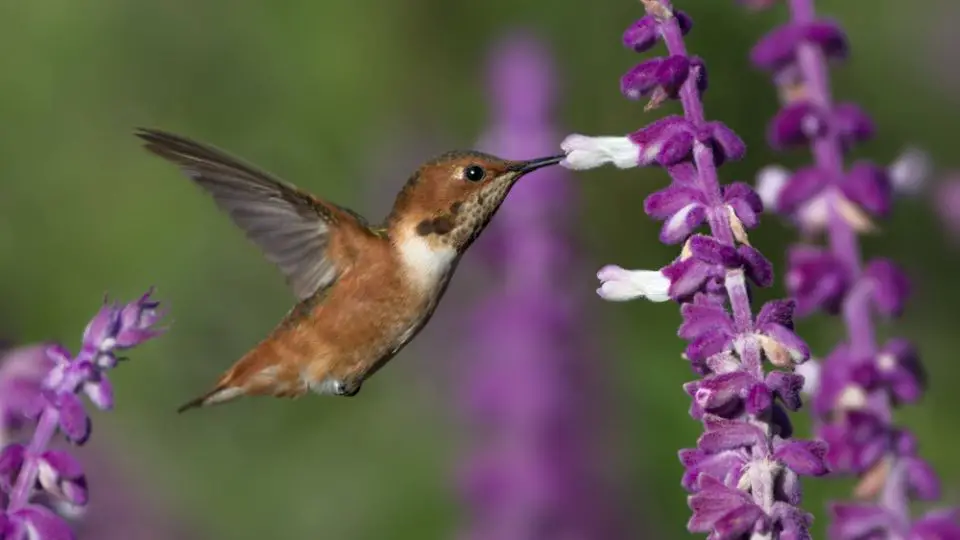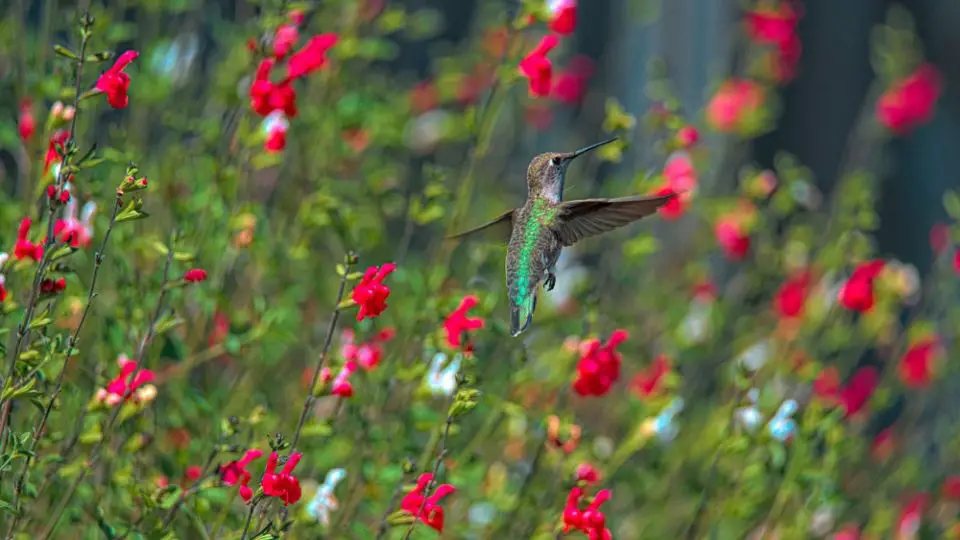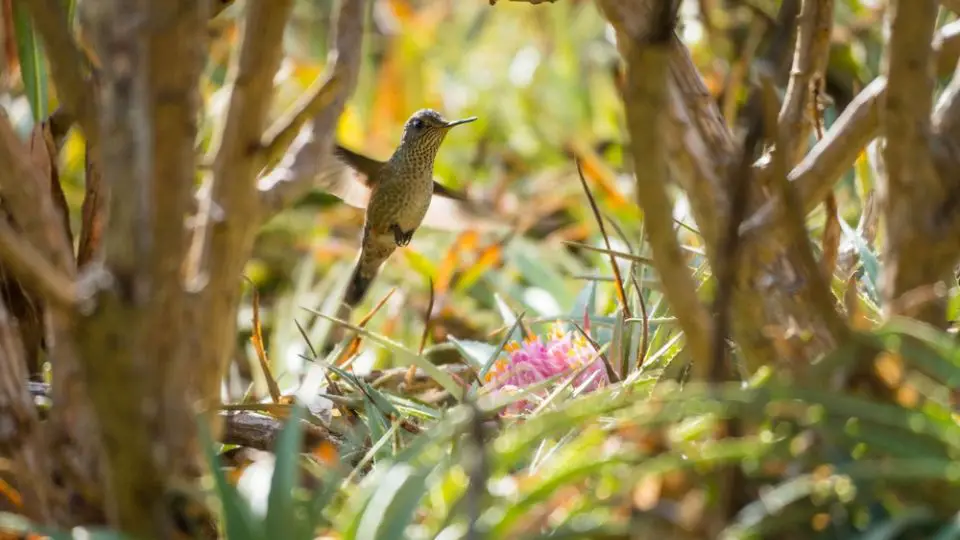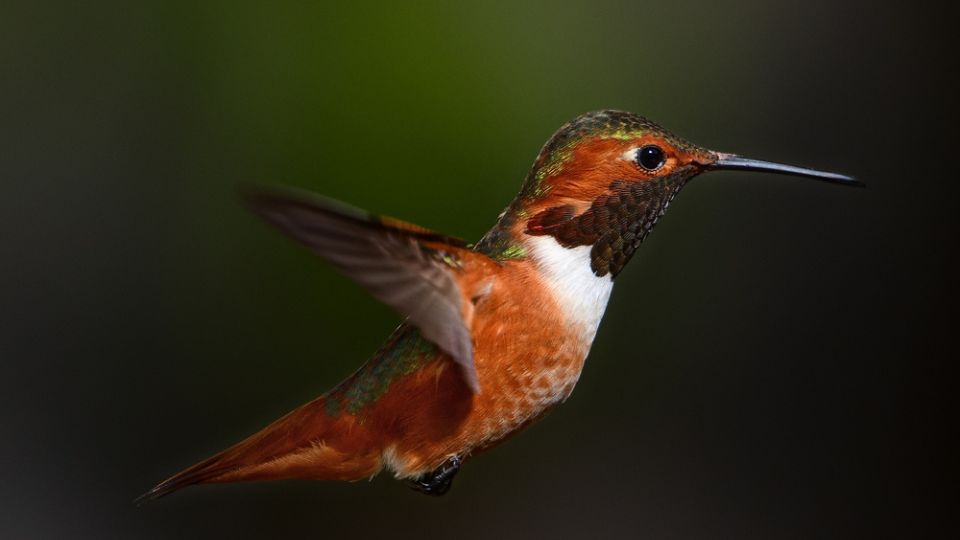Hummingbirds migrate to New Hampshire by the first week of May and leave by October. Ruby-throated, Rufous, Calliope, and Anna’s Hummingbirds have been reported. The Ruby-throated is the most common New Hampshire hummingbird.
Several species of hummingbirds migrate between Central America and Canada. They fly through many US states on their way to summer breeding grounds in the spring or to warmer climates in the fall. The dominant hummingbirds in the US are the Ruby-throated, Rufous, Anna’s, and Black-chinned Hummingbirds.
Learn more about hummingbird migration and the accidental species reported in New Hampshire. Find out which plants are hummingbird friendly and how to make your own sugar water to feed these tiny birds.
Table of Contents
When Do Hummingbirds Arrive In New Hampshire?
Hummingbirds arrive in New Hampshire in late April or early May. Some species simply pass through New Hampshire on their way north to Canada. The Ruby-throated hummingbird, however, migrates to New Hampshire for breeding. New Hampshire sees four species of hummingbirds between early spring and late fall.
Hang feeders by mid-April to help migrants and attract seasonal hummingbirds. Birdwatchers in New Hampshire report the Ruby-throated Hummingbird, Rufous Hummingbird, Anna’s Hummingbird, and the Calliope Hummingbird. Sightings of the Ruby-throated Hummingbird are most common, with the three other species reported only occasionally.
Hummingbird Migration Patterns
Most hummingbirds live in South and Central America. Around 14 of over 320 species of hummingbirds migrate to North America each spring. Unlike other birds that migrate in flocks, hummingbirds migrate alone. Male hummingbirds begin spring migration first, followed a week or two later by females.
Hummingbirds generally follow the same migration route from year to year. Some hummingbirds fly as fast as 60 miles per hour. This is quite a feat for a bird that is generally less than 4 inches long. Some hummingbirds fly just a few hours a day, but the Ruby-throated Hummingbird flies for 18-22 hours at a time while crossing the Gulf of Mexico.

Do Hummingbird return to their birthplace?
Hummingbirds usually return to their birthplace each year for breeding season. Males arrive at breeding grounds first and wait. Once females arrive, the male hummingbird selects a female and begins his courtship ritual.
He flashes his feathers and performs daring dives in the air. If the female chooses him, he mates with her before flying away to repeat his ritual with another female. Females are solely responsible for building nests and raising young.
Each species of hummingbird, however, has different migration habits. One hummingbird species, Anna’s Hummingbird, doesn’t migrate and lives on the Pacific Coast year-round. Costa’s Hummingbird migrates in a small area, mainly between California, Arizona, and New Mexico.
Allen’s Hummingbird has a narrow range up the Pacific Coast and into Mexico. The Broad-billed stays primarily in the southwestern US. Moreover, the Broad-tailed migrates between Utah, Nevada, and southern Mexico.
How Long Do Hummingbirds Stay In New Hampshire?
Hummingbirds stay in New Hampshire until the end of September. Reversing their spring migration pattern, males leave for fall migration first. Females stay to finish raising young and follow the males south a week or two later. Hummingbirds are gone from New Hampshire by October.
Where Do New Hampshire Hummingbirds Go In Winter?
Most species of hummingbirds fly south for the winter. The Ruby-throated Hummingbird migrates to the Gulf Coast states of Mississippi, Florida, Louisiana, Alabama, and Georgia. Some Ruby-throated cross the Gulf of Mexico and overwinter in Mexico or Panama.
Rufous Hummingbirds and Calliope Hummingbirds migrate down the west coast to Mexico for the winter. As stated above, Anna’s Hummingbirds typically don’t migrate, ranging from Oregon down the Pacific Coast year-round.
When Does The Last Hummingbird Leave New Hampshire?
Sightings of the last hummingbird generally occur in October. Before migrating south, hummingbird feed more often. Late summer through early fall is the absolute best time of year to see hummingbirds.
The males feed heavily to store fat for migration—some gain as much as 40% of their body weight in preparation. The females are almost finished raising young and are training them to eat from hummingbird feeders. Leave hummingbird feeders out until mid-October to make sure all migrating hummingbirds have quick food sources.

Tips For Feeding Hummingbirds
Hang Feeders
Hang feeders on your balcony or in your yard. Hummingbirds feed on sugar water, as well as flower nectar and small insects. Hummingbirds remember where their food sources are year after year, so once they find you, they’ll keep coming back! Make your own hummingbird nectar out of 4 cups of boiling water to 1 cup of sugar.
Plant a Garden
Hummingbirds not only feed on flower nectar but on the small insects attracted to the flowers. Because of their fast metabolisms, hummingbirds need constant access to food. As the hummingbird season progresses, hummingbirds will be frequent visitors to your garden. Even a few potted plants will provide nourishing food.
Include plants like:
- Bee balm
- Columbine
- Foxglove
- Goldenrod
- Milkweed
- Trumpet honeysuckle
Hummingbirds are attracted to tubular-shaped flowers. They have long beaks and tongues that allow them to feed from flowers that would otherwise be too deep for other pollinators. Hummingbirds can also see the color red better than other pollinators, so they target red-colored flowers because there isn’t as much competition for them.
Hummingbirds In New Hampshire
As a year-round resident of New Hampshire, the Ruby-throated Hummingbird is the most common hummingbird reported in the state. The eastern US states, including Maryland, Delaware, New Jersey, and Vermont, all support breeding grounds for the Ruby-throated Hummingbird. The Ruby-throated is actually the only hummingbird that breeds east of the Mississippi River.
Ruby-throated Hummingbirds arrive by the first week of May and stay until September. Ruby-throated Hummingbirds range from Maine through Pennsylvania, West Virginia, Kentucky, Minnesota, Missouri, and into Texas, where it shares areas with the Black-chinned Hummingbird.
The male Ruby-throated Hummingbird is known for the ruby-red patch on his gorget (throat). He has iridescent green feathers on his back and a white underbelly. The female Ruby-throated lacks the red throat. She has duller green back feathers and the same white underbelly. Ruby-throated are very common at backyard feeders throughout the Eastern US.
Less Common Hummingbirds
Rufous Hummingbird
The Rufous Hummingbird, seen occasionally, usually passes through New Hampshire on its way to Canada or back to the western US. Sightings of Rufous have been reported in most US states, including Kansas, Massachusetts, and Michigan.
The Rufous Hummingbird breeds the farthest north of any hummingbird. It ventures into southeastern Alaska, and typically stays in the western US. Rufous Hummingbirds can be identified by their brilliant orange feathers.
Anna’s Hummingbird
Anna’s Hummingbirds usually stay on the Pacific Coast but has been reported in New Hampshire, Wisconsin, Ohio, and many other US states. Male Anna’s Hummingbirds have reddish-pink patches on their head and throat. They have green back feathers and can have lighter green underbelly feathers. Female Anna’s lack the colorful head and throat patches.

Rare Hummingbirds
Calliope Hummingbirds
Calliope Hummingbirds are rare vagrants to New Hampshire. This species stays mainly west of Kansas, with sightings in the midwest and eastern US very rare. Calliope Hummingbirds are the smallest US hummingbird, weighing less than a penny.
Male Calliope’s have a magenta pink throat patch that descends slightly down their sides, and green top feathers. Females are mostly green and white. However, their underbellies can have a peachy color.

